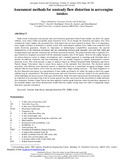JavaScript is disabled for your browser. Some features of this site may not work without it.
| dc.contributor.author | Gil-Prieto, Daniel | |
| dc.contributor.author | MacManus, David G. | |
| dc.contributor.author | Zachos, Pavlos K. | |
| dc.contributor.author | Bautista, Abian | |
| dc.date.accessioned | 2017-10-31T14:21:22Z | |
| dc.date.available | 2017-10-31T14:21:22Z | |
| dc.date.issued | 2017-10-27 | |
| dc.identifier.citation | Gil-Prieto D, MacManus DG, Zachos PK, Bautista A, Assessment methods for unsteady flow distortion in aero-engine intakes, Aerospace Science and Technology, Volume 72, January 2018, Pages 292-304 | en_UK |
| dc.identifier.issn | 1270-9638 | |
| dc.identifier.uri | http://dx.doi.org/10.1016/j.ast.2017.10.029 | |
| dc.identifier.uri | https://dspace.lib.cranfield.ac.uk/handle/1826/12689 | |
| dc.description.abstract | Peak events of unsteady total pressure and swirl distortion generated within S-duct intakes can affect the engine stability, even when within acceptable mean distortion levels. Even though the distortion descriptors have been evaluated in S-duct intakes, the associated flow field pattern has not been reported in detail. This is of importance since engine tolerance to distortion is usually tested with representative patterns from intake tests replicated with steady distortion generators. Despite its importance in intake/engine compatibility assessments, the spectral characteristics of the distortion descriptors and the relationship between peak unsteady swirl and both radial and circumferential total pressure distortion has not been assessed previously. The peak distortion data is typically low-pass filtered at a frequency associated with the minimum response time of the engine. However the engine design is not always known a priori in intakes investigations and a standard approach to reporting peak distortion data is needed. In addition, expensive and time-consuming tests are usually required to capture representative extreme distortion levels. This work presents a range of analyses based on Delayed Detached-Eddy Simulation and Stereo Particle Image Velocimetry data to assess these aspects of the unsteady flow distortion. The distorted pattern associated with different swirl distortion metrics is identified based on a conditional averaging technique, which indicates that the most intense swirl events are associated with a single rotating structure. . The main frequencies of the flow distortion descriptors in a representative S-duct intake are found to lie within the range in which the engine stability may be compromised. The peak total pressure and swirl distortion events are found to be not synchronous, which highlights the need to assess both types of distortion. Peak swirl and total-pressure distortion data is reported as a function of its associated time scale in a more general way that can be used in the assessment of intake unsteady flow distortion. Extreme Value Theory has been applied to predict peak distortion values beyond those measured in the available dataset, and whose measurement would otherwise require testing times two orders of magnitude longer than those typically considered. | en_UK |
| dc.language.iso | en | en_UK |
| dc.publisher | Elsevier | en_UK |
| dc.rights | Attribution-Non-Commercial-No Derivatives 4.0 | |
| dc.rights.uri | http://creativecommons.org/licenses/by-nc-nd/4.0/ | |
| dc.subject | Extreme value theory | en_UK |
| dc.subject | Unsteady distortion | en_UK |
| dc.subject | PIV | en_UK |
| dc.subject | DDES | en_UK |
| dc.subject | S-duct | en_UK |
| dc.title | Assessment methods for unsteady flow distortion in aero-engine intakes | en_UK |
| dc.type | Article | en_UK |
Files in this item
This item appears in the following Collection(s)
-
Staff publications (SATM) [4410]

